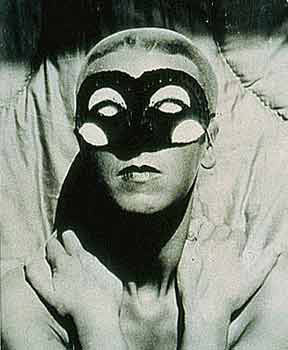
was a French artist, photographer and writer.
Her work was both political and personal,
and often played with the concepts of gender and sexuality.
Born Lucy Renee Mathilde Schwob in Nantes, she was the niece of writer Marcel Schwob and the great-niece of Orientalist David Léon Cahun. Her mother's mental problems meant that she was brought up by her paternal grandmother, Mathilde Cahun.
She began making photographic self-portraits as early as 1912, when she was 18 years old, and she continued taking images of herself through the 1930s.
Around 1919, she settled on the pseudonym Claude Cahun, intentionally selecting a sexually ambiguous name, after having previously used the names Claude Courlis (after the curlew) and Daniel Douglas (after Lord Alfred Douglas). During the early 20s, she settled in Paris with her life-long partner and stepsister Suzanne Malherbe. For the rest of their lives together, Cahun and Malherbe (who adopted the pseudonym "Marcel Moore") collaborated on various written works, sculptures, photomontages and collages. She published articles and novels, notably in the periodical "Mercure de France", and befriended Henri Michaux, Pierre Morhange and Robert Desnos.
Around 1922 she and Malherbe began holding artists' salons at their home. Among the regulars who would attend were artists Henri Michaux and André Breton and literary entrepreneurs Sylvia Beach and Adrienne Monnier.
Cahun's work encompassed writing, photography, and theater. She is most remembered for her highly-staged self portraits and tableaux that incorporated the visual aesthetics of Surrealism.
Her published writings include "Heroines," (1925) a series of monologues based upon female fairy tale characters and intertwining them with witty comparisons to the contemporary image of women; Aveux non avenus, (Carrefour, 1930) a book of essays and recorded dreams illustrated with photomontages; and several essays in magazines and journals.
In 1932 she joined the Association des Ecrivains et Artistes Révolutionnaires, where she met André Breton and René Crevel. Following this, she started associating with the surrealist group, and later participated in a number of surrealist exhibitions, including the London International Surrealist Exhibition (New Burlington Gallery) and Exposition surréaliste d'Objets (Charles Ratton Gallery, Paris), both in 1936. In 1934, she published a short polemic essay, Les Paris sont Ouverts, and in 1935 took part in the founding of the left-wing group Contre Attaque, alongside André Breton and Georges Bataille.
One of Cahun's last works, "The Path of the Cats," shows her blindfolded as she is led by a cat. It deals with "a fundamental questioning of reality and appearances," the curators write. "Cahun cherished cats, which symbolized the intercessor par excellence, ensuring intuitive contact between the visible and the invisible, opening the door to worlds of the senses both unknown and perfectly close."
In 1937 Cahun and Malherbe settled in Jersey. Following the fall of France and the German occupation of Jersey and the other Channel Islands, they became active as resistance workers and propagandists. Fervently against war, the two worked extensively in producing anti-German fliers. Many were snippets from English-to-German translations of BBC reports on the Nazi's crimes and insolence, which were pasted together to create rhythmic poems and harsh criticism. The couple then dressed up and attended many German military events in Jersey, strategically placing them in soldier's pockets, on their chairs, etc. Also, fliers were inconspicuously crumpled up and thrown into cars and windows. They were arrested by the Gestapo and almost put to death, before being spared at the eleventh hour. But the Germans pillaged their house, destroying a large number of their photographs. Partly due to this significant loss, Cahun's work was not rediscovered until the late 1980s, and since then it has provided fertile ground for art historians, cultural critics, and queer theorists alike. In many ways, Cahun and Malherbe's resistance efforts were not only political but artistic actions, using their creative talents to manipulate and undermine the authority which they despised. In many ways, Cahun's life's work was focused on undermining a certain authority, however her specific resistance fighting targeted a physically dangerous threat. In 1944 they were arrested and sentenced to death, but the sentences were never carried out. However, Cahun's health never recovered from her treatment in jail, and she died in 1954. She is buried in St Brelade's Church with her partner Suzanne Malherbe.
In many ways, Cahun's life was marked by a sense of role reversal, and her public identity became a commentary upon not only her own, but the public's notions of sexuality, gender, beauty, and logic. Her adoption of a sexually ambiguous name, and her androgynous self-portraits display a revolutionary way of thinking and creating, experimenting with her audience's understanding of photography as a documentation of reality. Her poetry challenged gender roles and attacked the increasingly modern world's social and economic boundaries. Also Cahun's participation in the Parisian Surrealist movement diversified the group's artwork and ushered in new representations. Where most Surrealist artists were men, and their primary images were of women as isolated symbols of eroticism, Cahun epitomized the chameleonic and multiple possibilities of the female identity. From her bold self-portraits to her Surrealist collages, Cahun had a poetic, fiercely intuitive sensibility that was unhampered by convention.Her photographs, writings, and general life as an artistic and political revolutionary continue to influence countless artists, namely Cindy Sherman and Nan Goldin.




Keine Kommentare:
Kommentar veröffentlichen